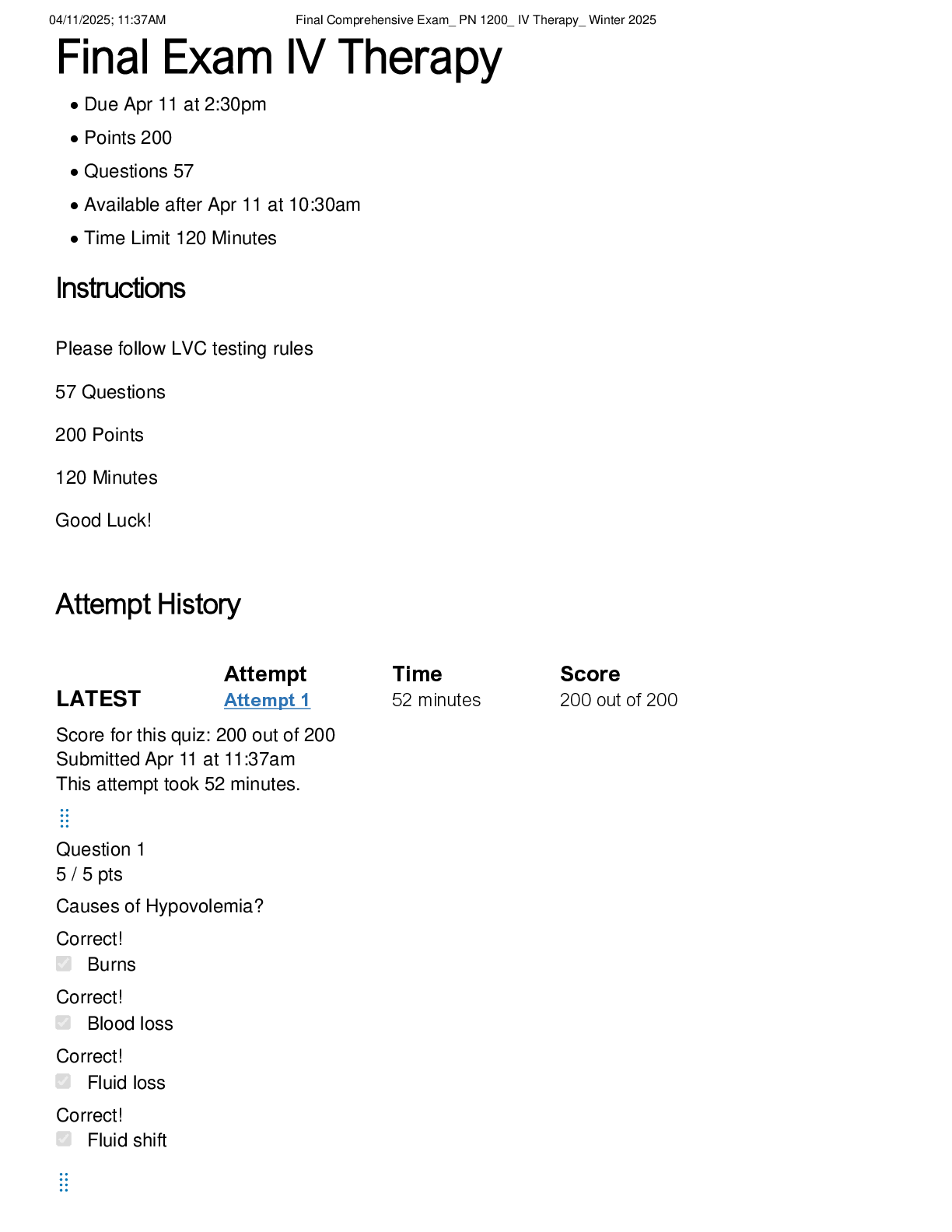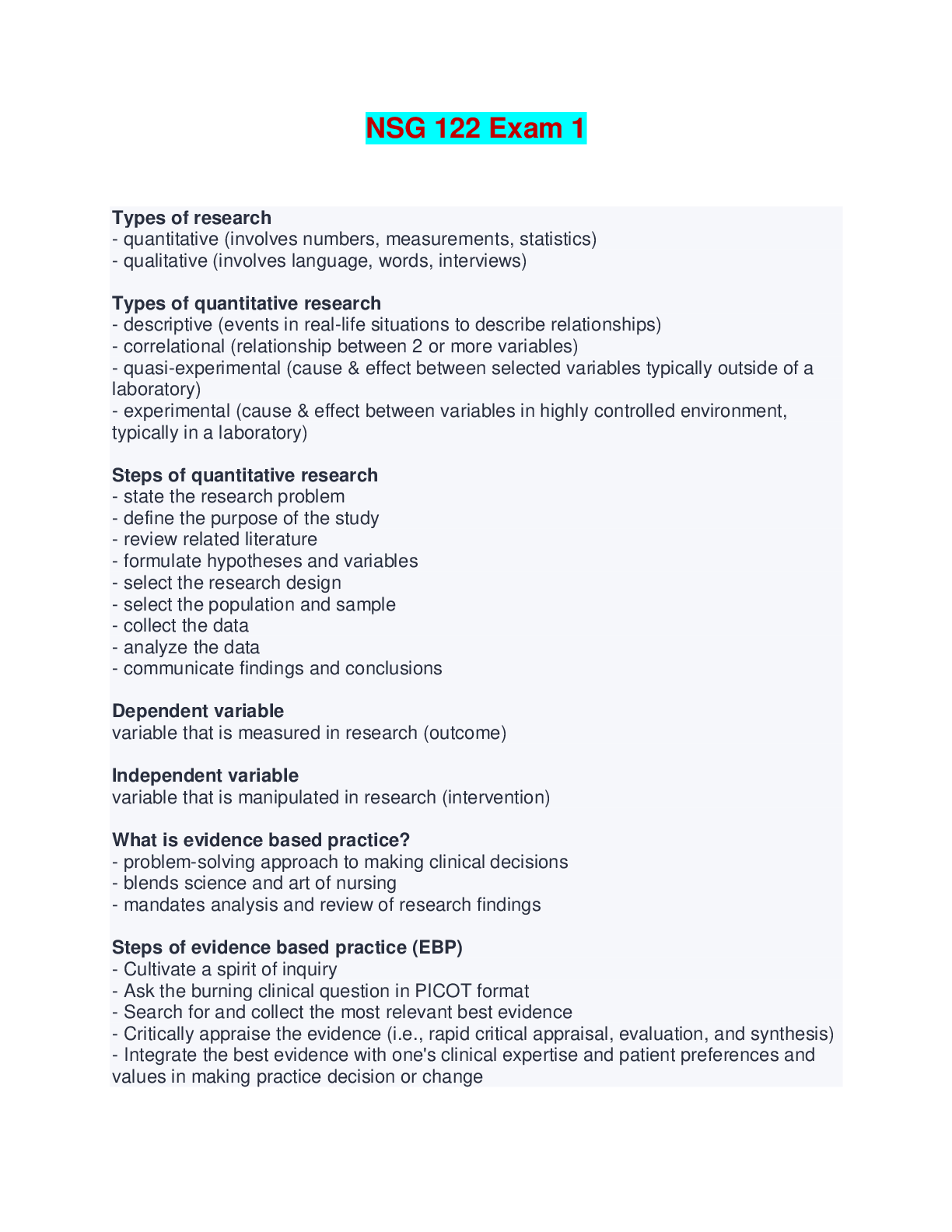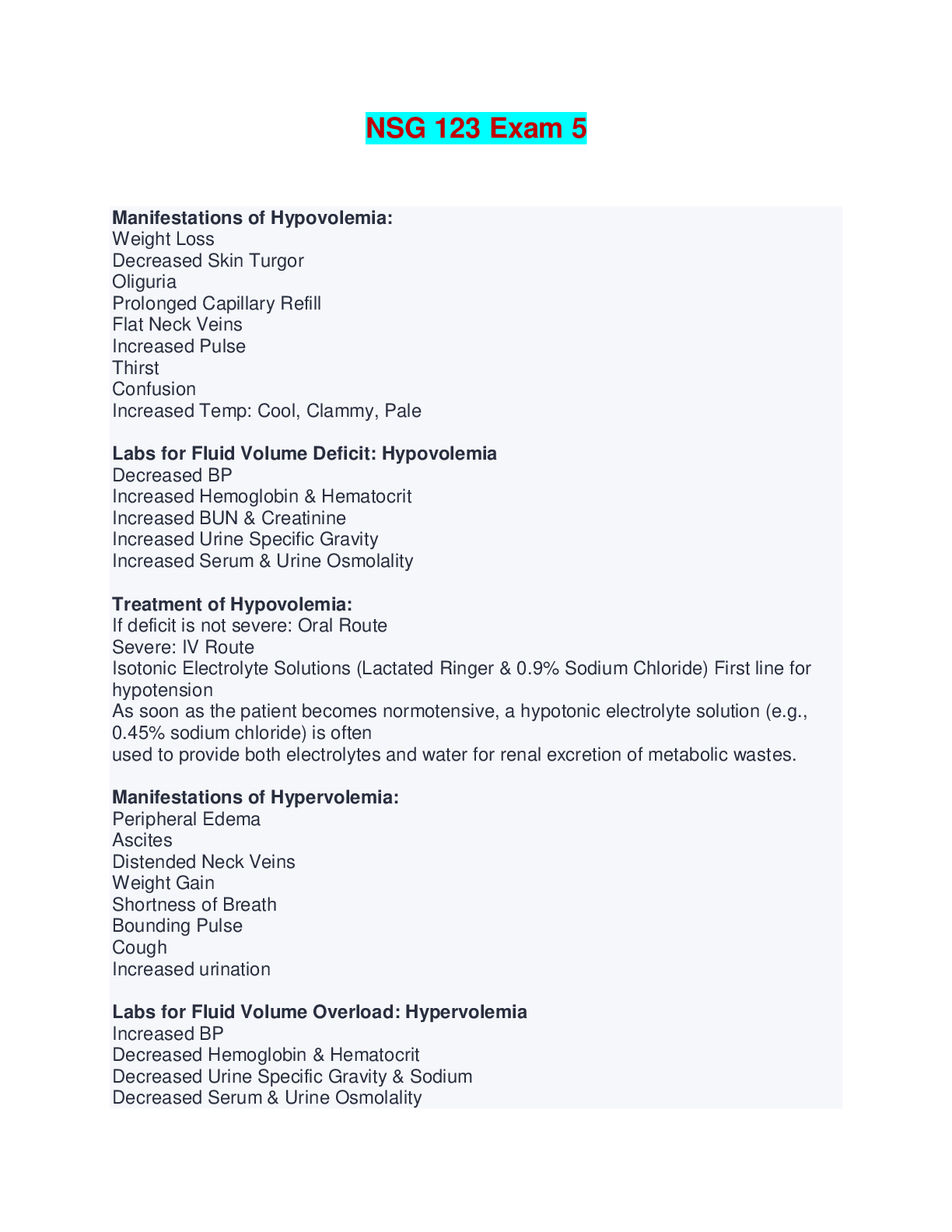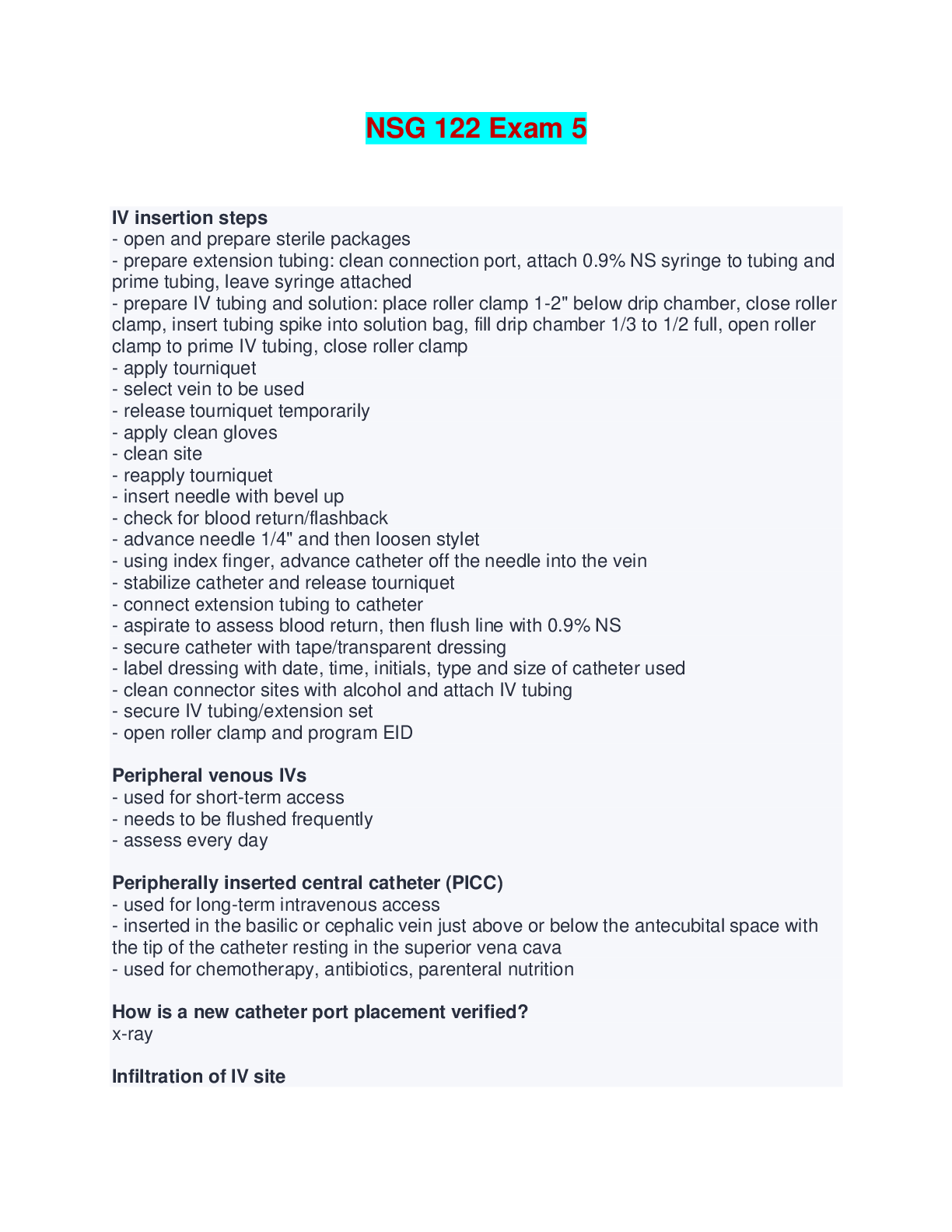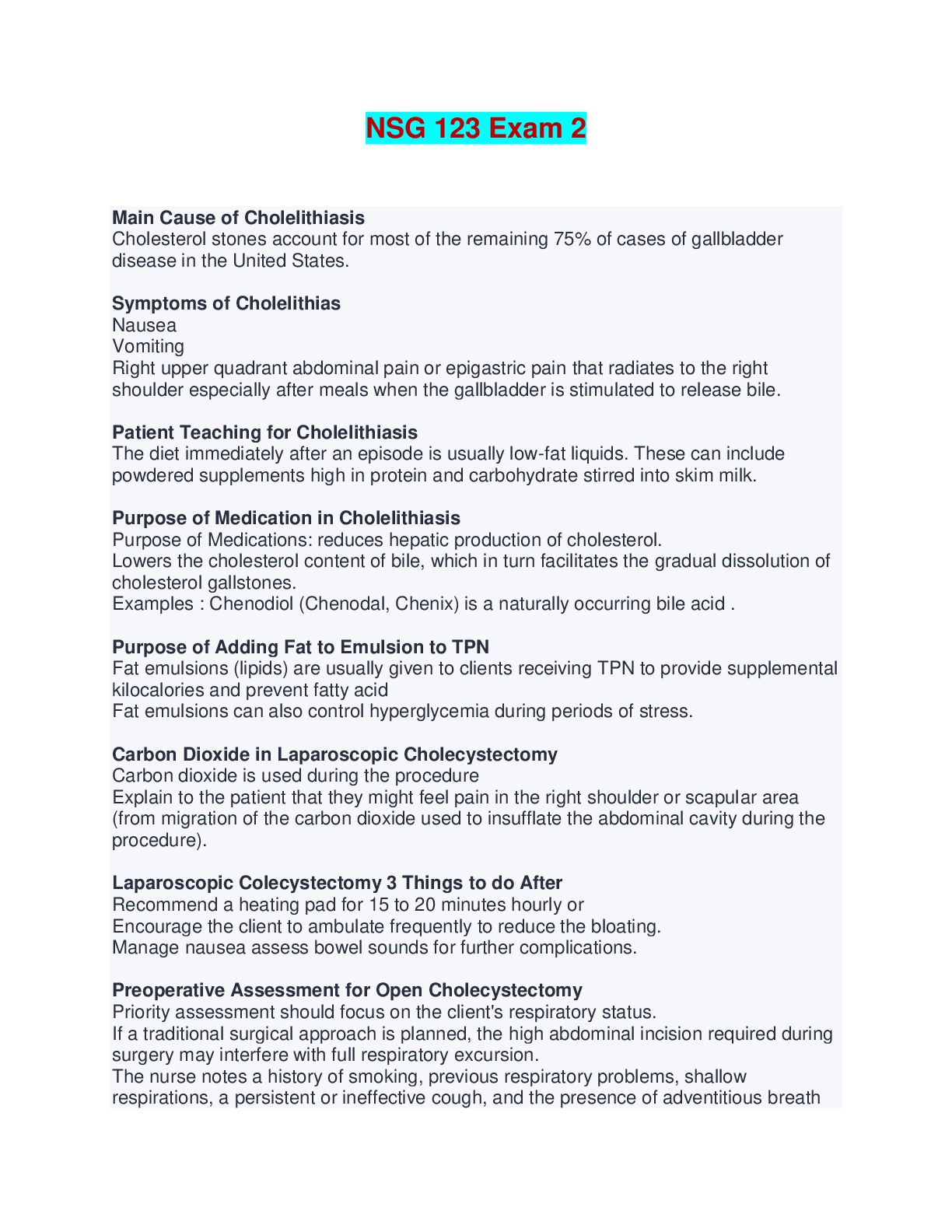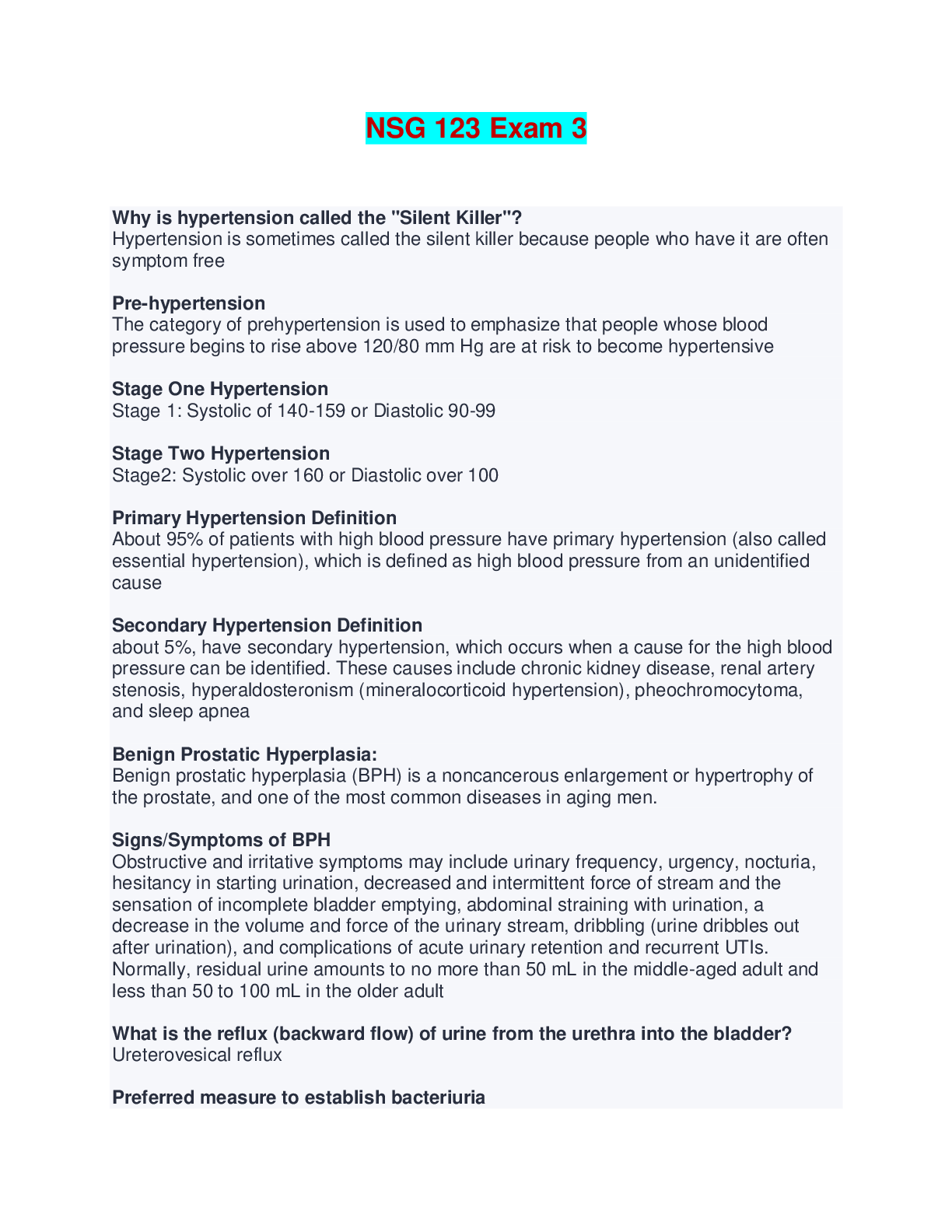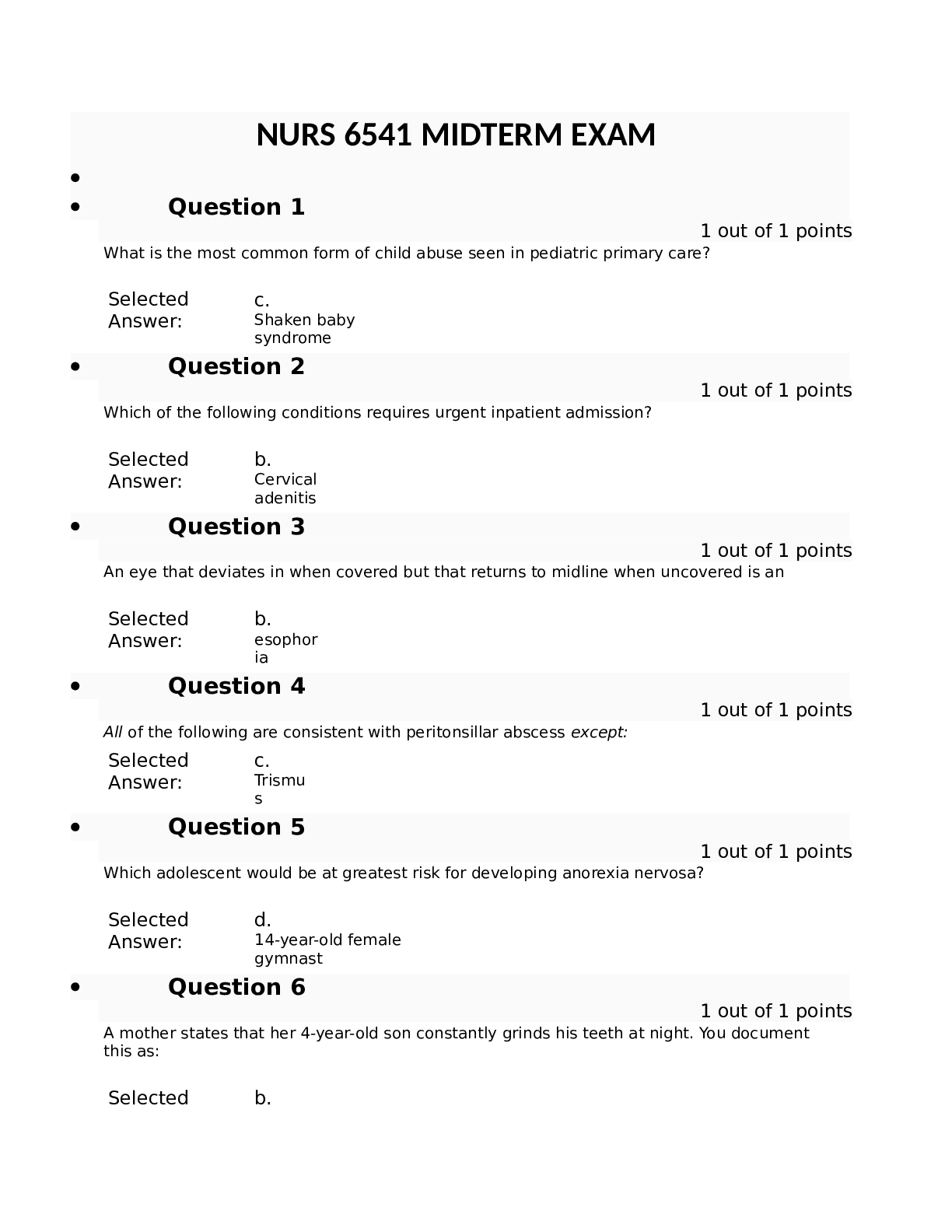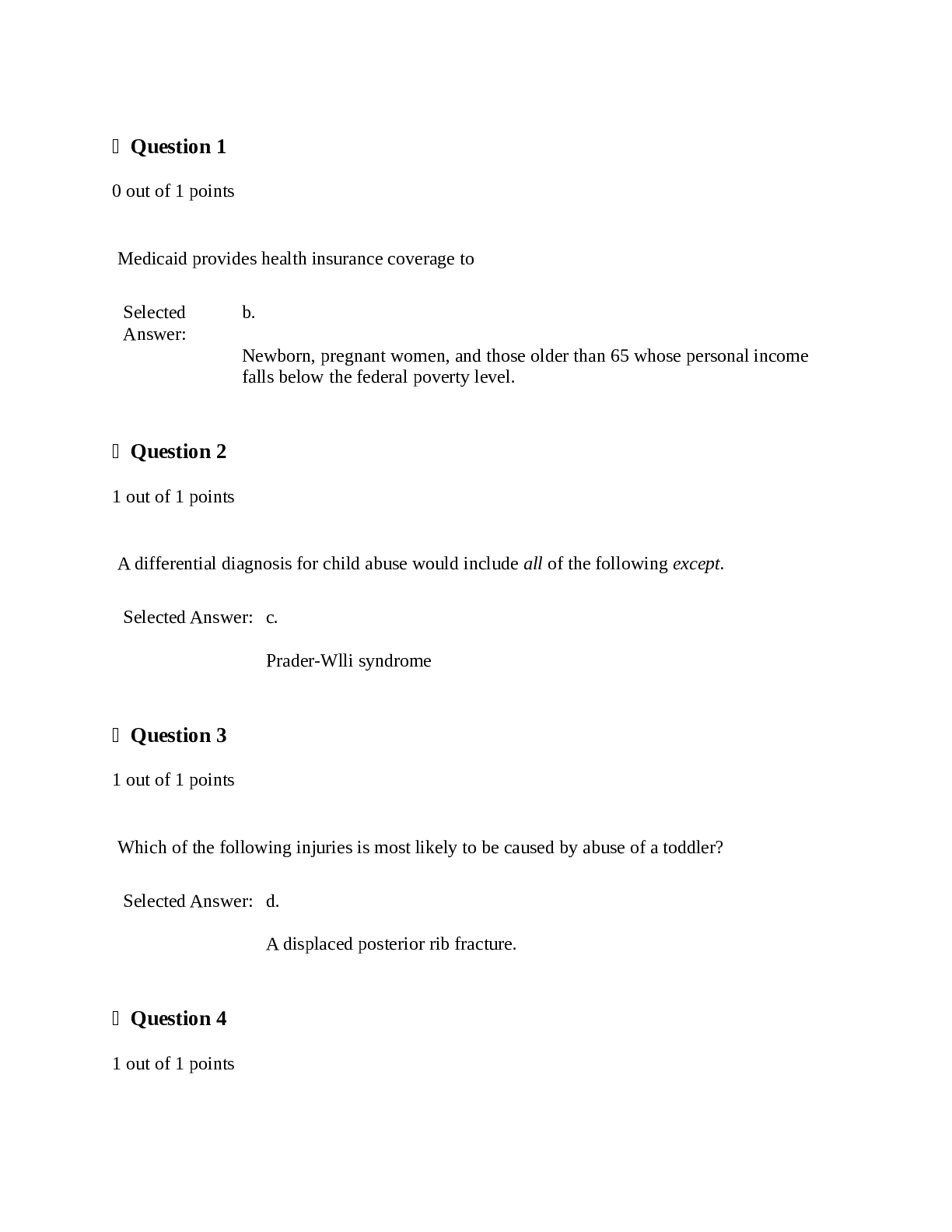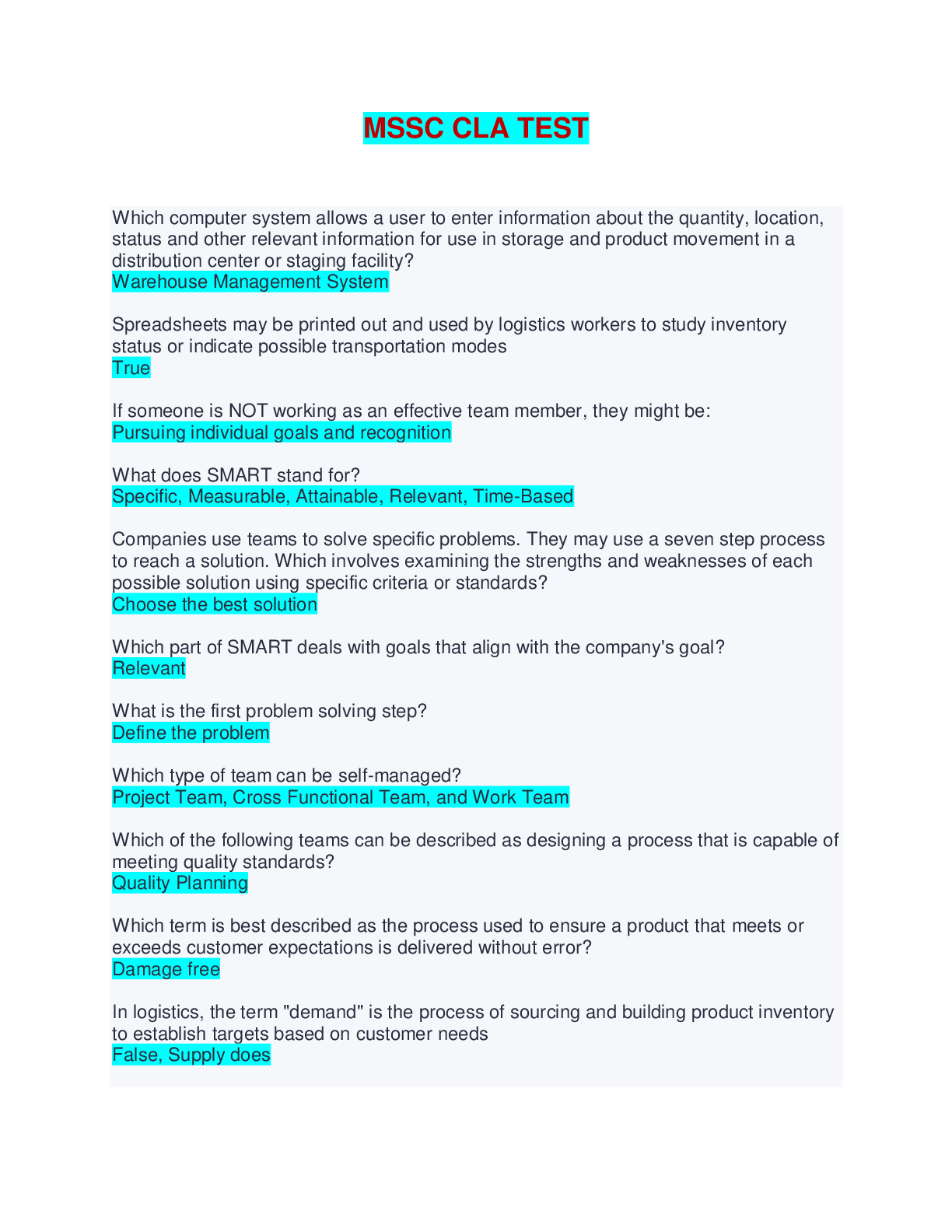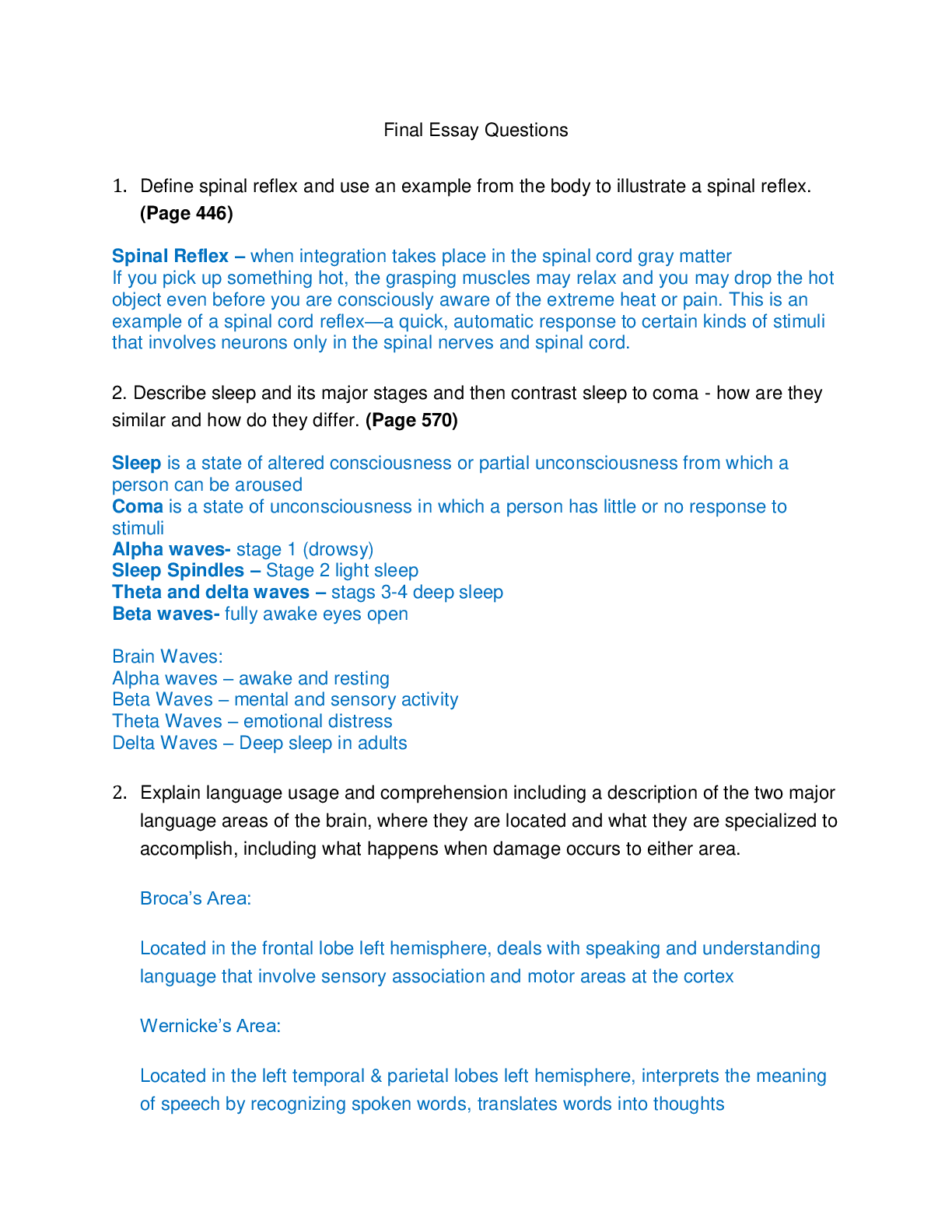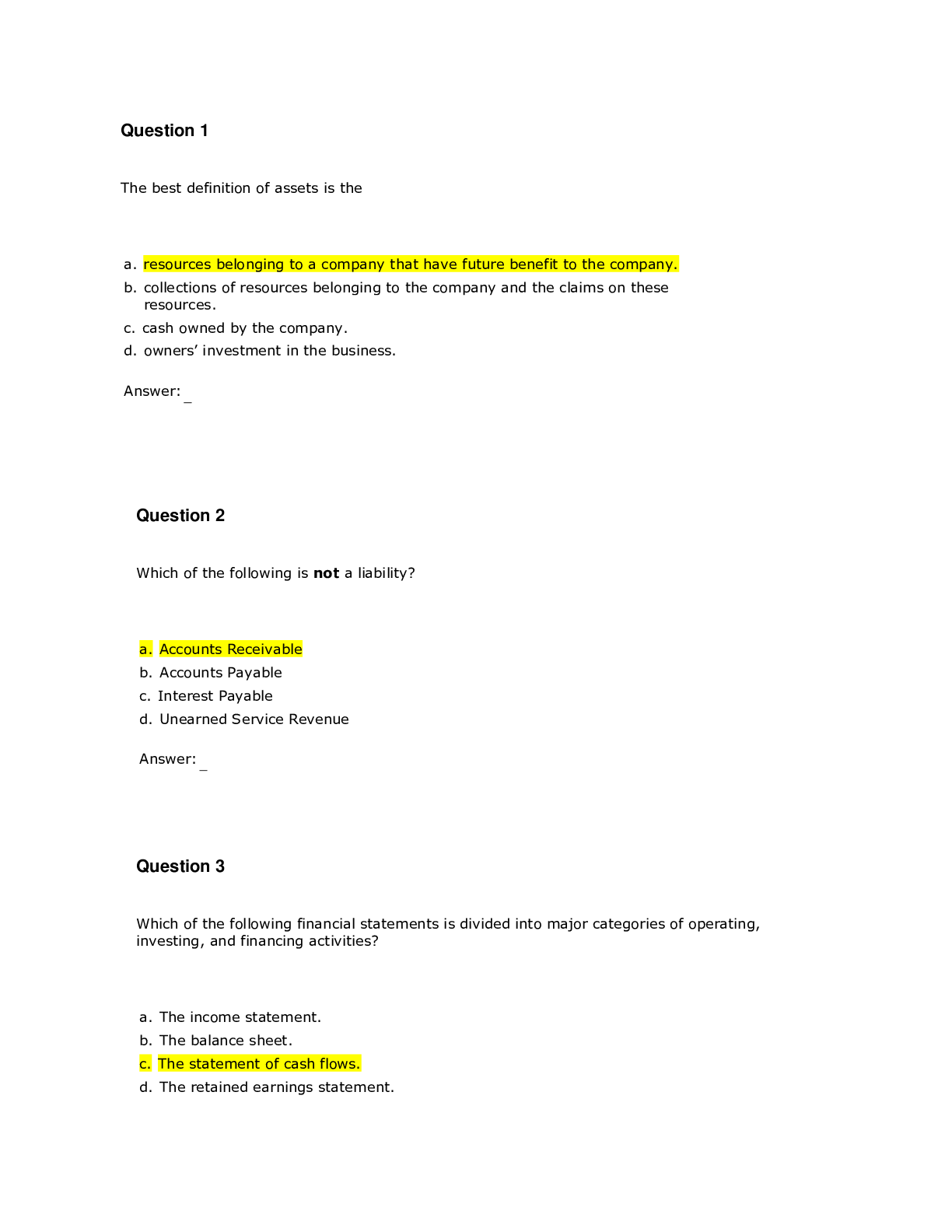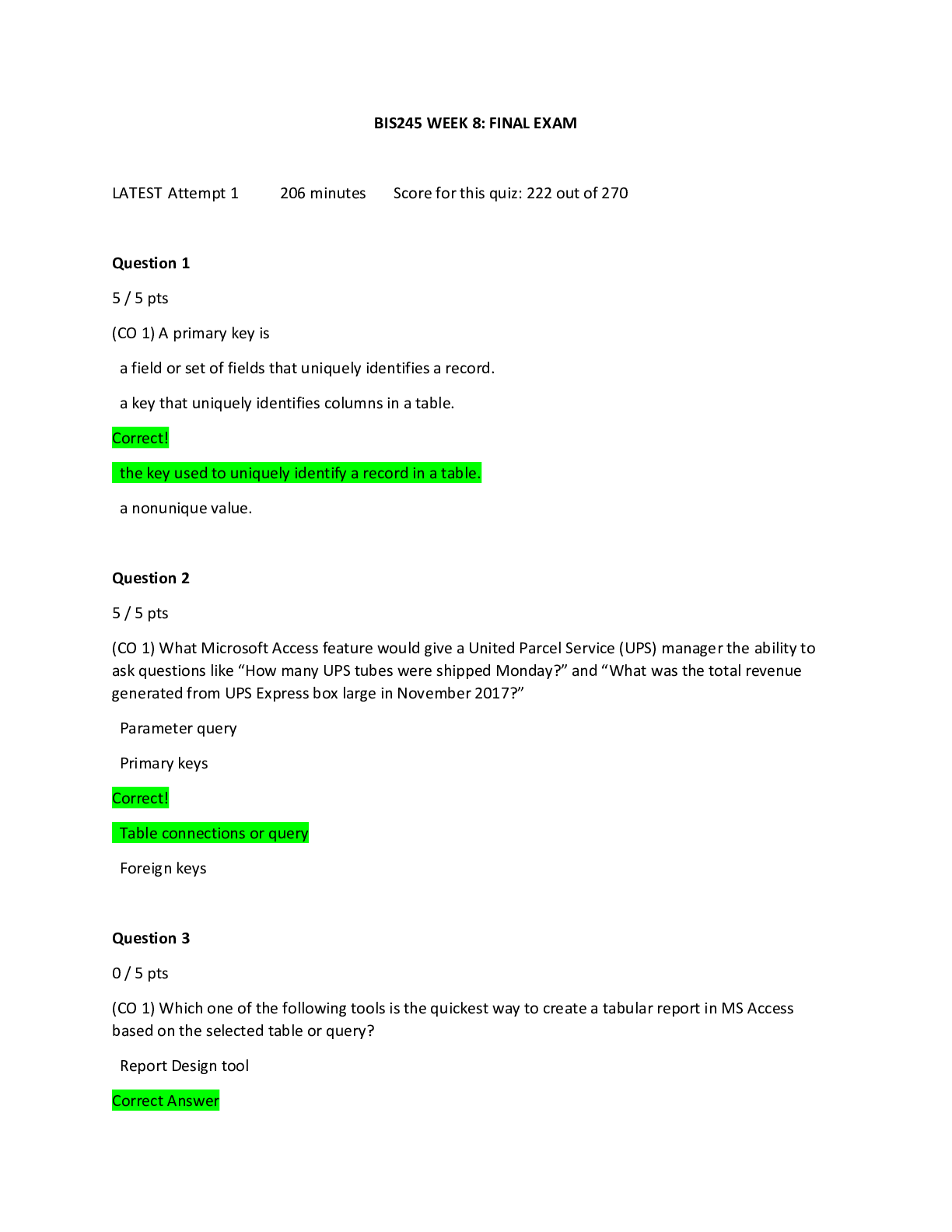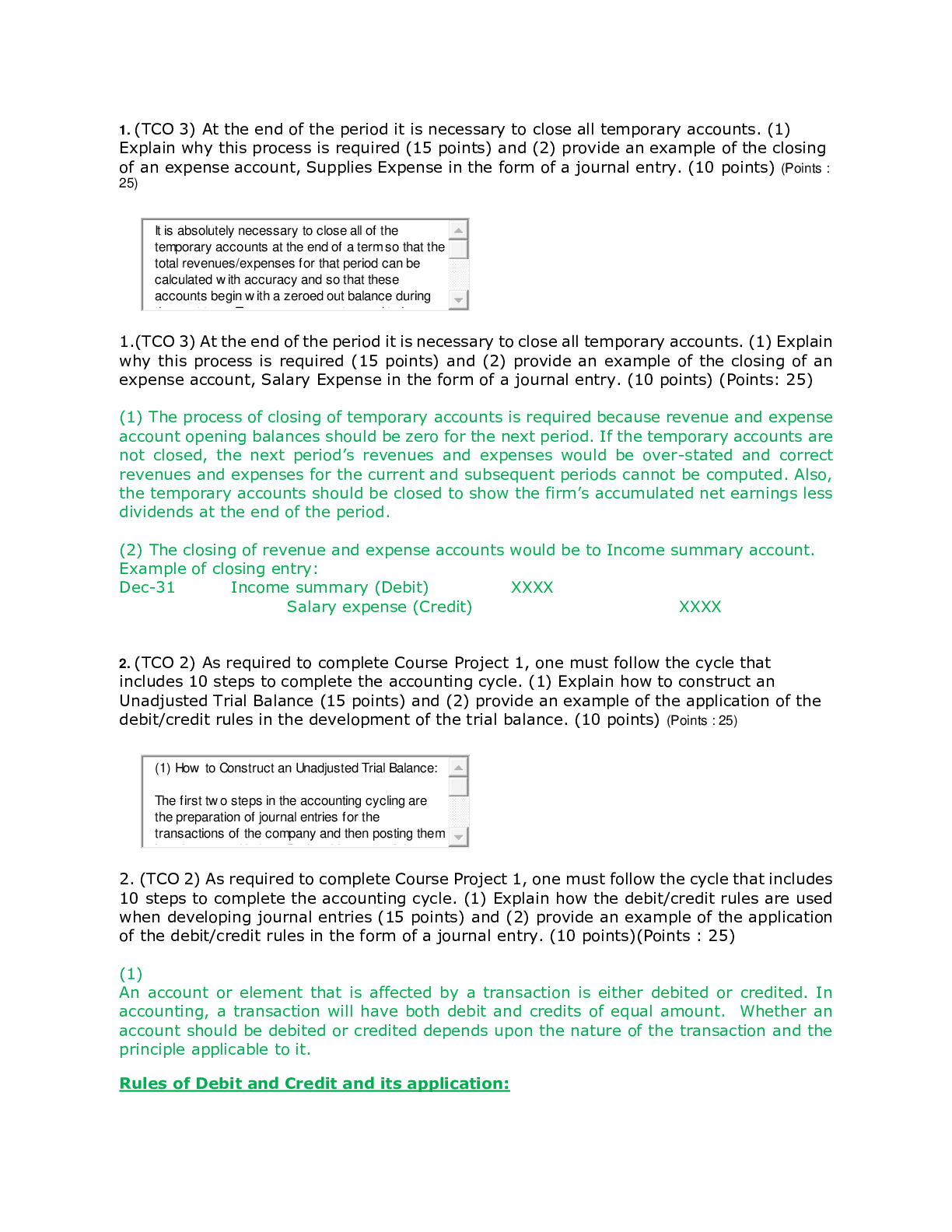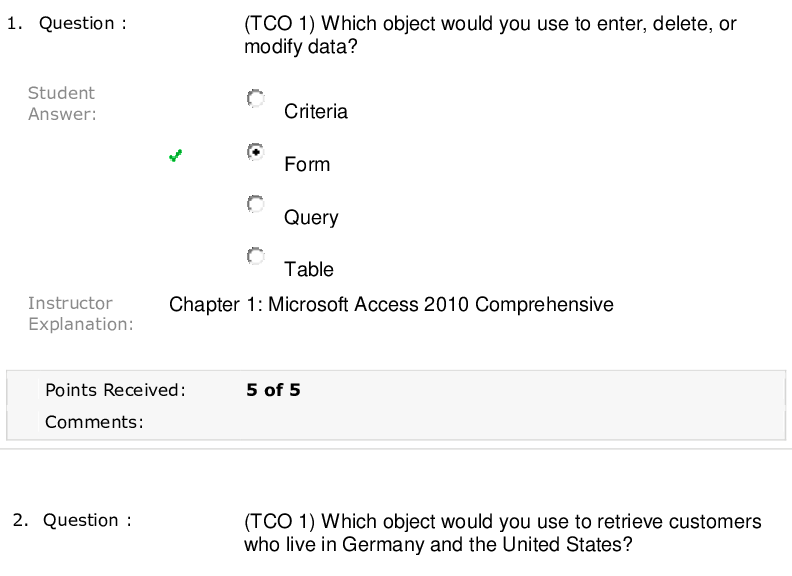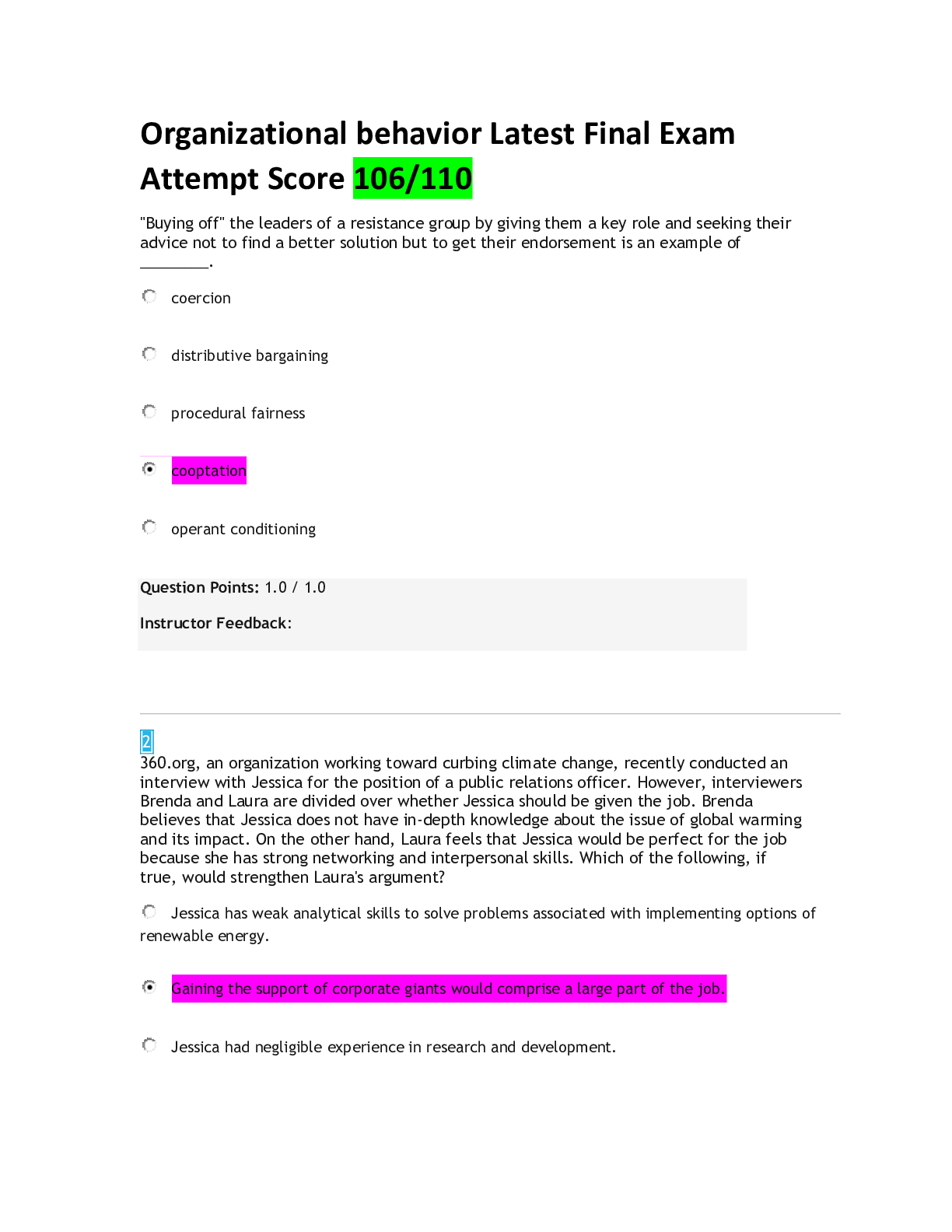ECON 201 Final Exam | Questions with complete solutions
Document Content and Description Below
ECON 201 Final Exam | Questions with complete solutions A profit-maximizing firm will: A. expand employment if marginal revenue product equals marginal resource cost. B. reduce employment if margina... l revenue product equals marginal resource cost. C. reduce employment if marginal revenue product is less than marginal resource cost. D. expand employment if marginal revenue product is less than marginal resource cost. Which of the following describes the equilibrium condition in a purely competitive labor market? A. MRP = Wage Rate B. MRP > Wage Rate C. Wage Rate > MRC D. Wage Rate < MRC A craft union attempts to increase wage rates by: A. equating the MRP and the MRC curves. B. shifting the labor supply curve to the left. C. shifting the labor supply curve to the right. D. shifting the MRP curve to the right. Compensating differences in wages: A. compensate workers for differences in their human capital. B. are wage differences that compensate for differences in the desirability of jobs. C. describe the tendency for the wages of all occupations to adjust to the median level. D. do not exist if jobs have different nonmonetary characteristics. Monopolistic competition is characterized by a: A. few dominant firms and low entry barriers. B. large number of firms and substantial entry barriers. C. large number of firms and low entry barriers. D. few dominant firms and substantial entry barriers. Nonprice competition refers to: A. competition between products of different industries, for example, competition between aluminum and steel in the manufacture of automobile parts. B. price increases by a firm that are ignored by its rivals. C. advertising, product promotion, and changes in the real or perceived characteristics of a product. D. reductions in production costs that are not reflected in price reductions. A monopolistically competitive industry combines elements of both competition and monopoly. The monopoly element results from: A. the likelihood of collusion. B. high entry barriers. C. product differentiation. D. mutual interdependence in decision making. The monopolistic competition model predicts that: A. allocative efficiency will be achieved. B. productive efficiency will be achieved. C. firms will engage in nonprice competition. D. firms will realize economic profits in the long run. The demand curve of a monopolistically competitive producer is: A. less elastic than that of either a pure monopolist or a pure competitor. B. less elastic than that of a pure monopolist, but more elastic than that of a pure competitor. C. more elastic than that of a pure monopolist, but less elastic than that of a pure competitor. D. more elastic than that of either a pure monopolist or a pure competitor. A monopolistically competitive firm's marginal revenue curve: A. is downsloping and coincides with the demand curve. B. coincides with the demand curve and is parallel to the horizontal axis. C. is downsloping and lies below the demand curve. D. does not exist because the firm is a "price maker." In the short-run, a profit-maximizing monopolistically competitive firm sets it price: A. equal to marginal revenue. B. equal to marginal cost. C. above marginal cost. D. below marginal cost. In the long-run, the price charged by the monopolistically competitive firm attempting to maximize profits: A. must be less than ATC. B. must be more than ATC. C. may be either equal to ATC, less than ATC, or more than ATC. D. will be equal to ATC. Monopolistically competitive firms: A. realize normal profits in the short run but losses in the long run. B. incur persistent losses in both the short run and long run. C. may realize either profits or losses in the short run, but realize normal profits in the long run. D. persistently realize economic profits in both the short run and long run. In the long-run, the price charged by a monopolistically competitive firm seeking to maximize profit will: A. be less than both MC and ATC. B. exceed ATC, but equal MC. C. exceed MC, but equal ATC. D. exceed both MC and ATC. In the long-run, economic theory predicts that a monopolistically competitive firm will: A. earn an economic profit. B. realize all economies of scale. C. equate price and marginal cost. D. have excess production capacity. Excess capacity refers to the: A. amount by which actual production falls short of the minimum ATC output. B. fact that entry barriers artificially reduce the number of firms in an industry. C. differential between price and marginal costs which characterizes monopolistically competitive firms. D. fact that most monopolistically competitive firms encounter diseconomies of scale. When a monopolistically competitive firm is in long-run equilibrium: A. production takes place where ATC is minimized. B. marginal revenue equals marginal cost and price equals average total cost. C. normal profit is zero and price equals marginal cost. D. economic profit is zero and price equals marginal cost. Other things equal, if more firms enter a monopolistically competitive industry: A. the demand curves facing existing firms would shift to the right. B. the demand curves facing existing firms would shift to the left. C. the demand curves facing existing firms would become less elastic. D. losses would necessarily occur. The economic inefficiencies of monopolistic competition may be offset by the fact that: A. advertising expenditures shift the average cost curve upward. B. available capacity is fully utilized. C. resources are optimally allocated to the production of the product. D. consumers have a number of variations of the product from which to choose. Inefficiencies occur under monopolistic competition because: A. each firm's demand curve becomes more elastic as we move down the curve. B. each firm's marginal revenue curve coincides with its demand curve. C. each firm's downsloping demand curve is tangent to the ATC curve in the long run. D. entry barriers greatly restrict the entry of new firms. A significant benefit of monopolistic competition compared with pure competition is: A. less likelihood of X-inefficiency. B. improved resource allocation. C. greater product variety. D. stronger incentives to achieve economies of scale. In monopolistically competitive markets resources are: A. overallocated because long-run equilibrium occurs where price exceeds marginal cost. B. underallocated because long-run equilibrium occurs where price exceeds marginal cost. C. overallocated because long-run equilibrium occurs where marginal cost exceeds price. D. underallocated because long-run equilibrium occurs where marginal cost exceeds price. Oligopolistic industries are characterized by: A. a few dominant firms and substantial entry barriers. B. a few dominant firms and no barriers to entry. C. a large number of firms and low entry barriers. D. a few dominant firms and low entry barriers. Which of the following is a unique feature of oligopoly? A. mutual interdependence B. advertising expenditures C. product differentiation D. nonprice competition Mutual interdependence means that each oligopolistic firm: A. faces a perfectly elastic demand for its product. B. must consider the reactions of its rivals when it determines its price policy. C. produces a product identical to those of its rivals. D. produces a product similar but not identical to the products of its rivals. Suppose an oligopolistic producer assumes its rivals will ignore a price increase but match a price cut. In this case the firm perceives its: A. demand curve as being of unit elasticity throughout. B. supply curve as kinked, being steeper below the going price than above. C. demand curve as kinked, being steeper below the going price than above. D. demand curve as kinked, being steeper above the going price than below. The kinked-demand curve of an oligopolist is based on the assumption that: A. competitors will follow a price cut but ignore a price increase. B. competitors will match both price cuts and price increases. C. competitors will ignore a price cut but follow a price increase. D. there is no product differentiation. The kinked-demand curve describes a situation in which an oligopolist will be: A. interested in maintaining the going price unless there is a rather large change in costs. B. anxious to either increase or lower price. C. anxious to increase price but not to lower price. D. anxious to lower price but not to increase price. The kinked-demand curve model helps to explain price rigidity because: A. there is a gap in the marginal revenue curve within which changes in marginal cost will not affect output or price. B. demand is inelastic above and elastic below the going price. C. the model assumes firms are engaging in some form of collusion. D. the associated marginal revenue curve is perfectly elastic at the going price. The kinked-demand curve model of oligopoly: A. assumes a firm's rivals will ignore a price cut but match a price increase. B. embodies the possibility that changes in unit costs will have no effect on equilibrium price and output. C. assumes a firm's rivals will match any price change it may initiate. D. assumes a firm's rivals will ignore any price change it may initiate. OPEC provides an example of: A. a tacit understanding. B. noncollusive oligopoly. C. an international cartel. D. a monopolistically competitive industry. Oligopolistic firms engage in collusion to: A. minimize unit costs of production. B. realize allocative efficiency, that is, the P = MC level of output. C. earn greater profits. D. increase production. Cartels are difficult to maintain in the long run because: A. they are illegal in all industrialized countries. B. individual members may find it profitable to cheat on agreements. C. it is more profitable for the industry to charge a lower price and produce more output. D. entry barriers are insignificant in oligopolistic industries Three major means of collusion by oligopolists are: A. cartels, tacit understandings, and price leadership. B. market sharing, mutual interdependence, and product differentiation. C. cartels, kinked-demand pricing, and product differentiation. D. tacit understandings, P = MC pricing, and mutual interdependence. If the firms in an oligopolistic industry can establish an effective cartel, the resulting output and price will approximate those of: A. a purely competitive producer. B. a pure monopoly. C. a monopolistically competitive producer. D. an industry with a low four-firm concentration ratio. Product differentiation is present in: A. purely competitive markets only. B. monopolistically competitive markets only. C. oligopolistic markets only. D. both monopolistically competitive and oligopolistic markets. Pure monopoly means: A. any market in which the demand curve to the firm is downsloping. B. a standardized product being produced by many firms. C. a single firm producing a product for which there are no close substitutes. D. a large number of firms producing a differentiated product. A purely monopolistic industry: A. has no entry barriers. B. has a downward sloping demand curve. C. produces a product or service for which there are many close substitutes. D. earns only a normal profit in the long run. Pure monopolists may obtain economic profits in the long run because: A. of advertising. B. marginal revenue is constant as sales increase. C. of barriers to entry. D. of rising average fixed costs. For an imperfectly competitive firm: A. total revenue is a straight, upsloping line because a firm's sales are independent of product price. B. the marginal revenue curve lies above the demand curve because any reduction in price applies to all units sold. C. the marginal revenue curve lies below the demand curve because any reduction in price applies to all units sold. D. the marginal revenue curve lies below the demand curve because any reduction in price applies only to the extra unit sold. For a nondiscriminating imperfectly competitive firm: A. the marginal revenue curve lies above the demand curve. B. the demand and marginal revenue curves coincide. C. the demand curve intersects the horizontal axis where total revenue is at a maximum. D. marginal revenue will become zero at that output where total revenue is at a maximum. The pure monopolist's demand curve is relatively elastic: A. in the price range where total revenue is declining. B. at all points where the demand curve lies above the horizontal axis. C. in the price range where marginal revenue is negative. D. in the price range where marginal revenue is positive. For a pure monopolist marginal revenue is less than price because: A. the monopolist's demand curve is perfectly elastic. B. the monopolist's demand curve is perfectly inelastic. C. when a monopolist lowers price to sell more output, the lower price applies to all units sold. D. the monopolist's total revenue curve is linear and slopes upward to the right. The MR = MC rule: A. applies only to pure competition. B. applies only to pure monopoly. C. does not apply to pure monopoly because price exceeds marginal revenue. D. applies both to pure monopoly and pure competition. In the long run a pure monopolist will maximize profits by producing that output at which marginal cost is equal to: A. average total cost. B. marginal revenue. C. average variable cost. D. average cost. If a monopolist's marginal revenue is $3.00 and its marginal cost is $4.50, it will increase its profits by: A. reducing output and raising price. B. reducing both output and price. C. increasing both price and output. D. raising price while keeping output unchanged. A pure monopolist: A. will realize an economic profit if price exceeds ATC at the profit-maximizing/loss-minimizing level of output. B. will realize an economic profit if ATC exceeds MR at the profit-maximizing/loss-minimizing level of output. C. will realize an economic loss if MC intersects the downsloping portion of MR. D. always realizes an economic profit. A pure monopolist's short-run profit-maximizing or loss-minimizing position is such that price: A. equals marginal revenue. B. may be greater or less than ATC. C. will always equal ATC. D. always exceeds ATC. A profit-maximizing monopolist will set its price: A. as far above ATC as possible. B. along the elastic portion of its demand curve. C. where the marginal cost curve intersects the demand curve. D. as close as possible to the minimum point of ATC. Refer to the above diagram. If this industry is purely competitive, the profit-maximizing price and quantity will be: A. P3 and Q3. B. P1 and Q1. C. P2 and Q2. D. indeterminate on the basis of the information given. Refer to the above diagram. If this industry is comprised of only one seller, the profit-maximizing price and quantity will be: A. P3 and Q3. B. P1 and Q1. C. P2 and Q2. D. indeterminate on the basis of the information given. The supply curve of a pure monopolist: A. is that portion of its marginal cost curve which lies above average variable cost. B. is the same as that of a purely competitive industry. C. is its average variable cost curve. D. does not exist because prices are not "given" to a monopolist. Economic profit in the long run is: A. possible for both a pure monopoly and a pure competitor. B. possible for a pure monopoly, but not for a pure competitor. C. impossible for both a pure monopolist and a pure competitor. D. only possible when barriers to entry are nonexistent. Confronted with the same unit cost data, a monopolistic producer will charge: A. the same price and produce the same output as a competitive firm. B. a higher price and produce a larger output than a competitive firm. C. a higher price and produce a smaller output than a competitive firm. D. a lower price and produce a smaller output than a competitive firm. The profit-maximizing output of a pure monopoly is economically inefficient because in equilibrium: A. price equals minimum average total cost. B. marginal revenue equals marginal cost. C. marginal cost exceeds price. D. price exceeds marginal cost. Price discrimination refers to: A. selling a given product for different prices at two different points in time. B. any price above that which is equal to a minimum average total cost. C. the selling of a given product at different prices that do not reflect cost differences. D. the difference between the prices a purely competitive seller and a purely monopolistic seller would charge. A price discriminating pure monopolist will attempt to charge each buyer (or group of buyers): A. different prices to compensate for differences in the characteristics of the product. B. the same price if per unit cost is constant for each unit of the product. C. that price which equals the buyer's marginal cost. D. the maximum price each would be willing to pay. Other things equal, in which of the following cases would economic profit be the greatest? A. an unregulated monopolist which is able to engage in price discrimination B. an unregulated, nondiscriminating monopolist C. a regulated monopolist charging a price equal to average total cost D. a regulated monopolist charging a price equal to marginal cost If a monopolist engages in price discrimination, it will: A. realize a smaller profit. B. charge a higher price where individual demand is inelastic and a lower price where individual demand is elastic. C. produce a smaller output than when it did not discriminate. D. charge a competitive price to all its customers. When economists say that the demand for labor is a derived demand, they mean that it is: [Show More]
Last updated: 11 months ago
Preview 4 out of 19 pages

Loading document previews ...
Buy this document to get the full access instantly
Instant Download Access after purchase
Buy NowInstant download
We Accept:

Reviews( 0 )
$15.00
Can't find what you want? Try our AI powered Search
Document information
Connected school, study & course
About the document
Uploaded On
Jul 23, 2024
Number of pages
19
Written in
Additional information
This document has been written for:
Uploaded
Jul 23, 2024
Downloads
0
Views
38

